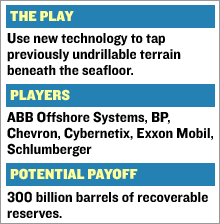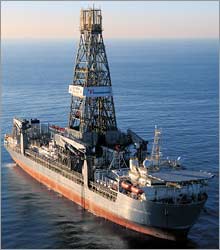|
Superdeep offshore drilling
NEW YORK (BUSINESS 2.0) - The hurricanes of '05 have made clear how important offshore wells in the Gulf of Mexico are to oil production. Before the storms hit, offshore rigs were responsible for 30 percent of U.S. production. As of the end of October, nearly a third of the gulf's rigs or pipelines were down, cutting production by 20 percent. Globally, nearly half of annual production comes from rigs boring into the seabed.
Most petroleum engineers believe that there's plenty more juice out there in the vast oceans. Now, thanks to the use of advanced fiber-optic technology, specially designed underwater drilling machines, and autonomous undersea robots, the hunt for hydrocarbons is reaching subsea depths it never could before. Using the latest technology, companies are tapping new reservoirs miles below the surface, off the coasts of Africa and Asia. Chevron and Transocean, a firm that owns deepwater drill ships, set a world record when they drilled a well almost two miles beneath the sea. "This is really one of the last frontiers for oil recovery," says Guy Cantwell, a spokesman for Transocean. All told, analysts at the U.S. Geological Survey estimate that nearly 300 billion barrels of oil still rest below the sea worldwide. Exxon Mobil and BP alone have invested nearly $15 billion in the past decade in an attempt to harvest oil deep under the seafloor, bets that, as oil prices have risen, seem all the shrewder. One of the biggest challenges is to control the drills when they're nearly three miles down the hole, which has led companies like Schlumberger to develop innovative drills that can generate real-time video feeds of their environment, in addition to seismic snapshots that allow the drill to be adjusted on the go by technicians at a console on the rig. In the Gulf of Mexico, BP has already deployed a $1 billion rig that can drill nearly five miles down from waters more than a mile deep. The harsh demands of superdeep drilling have already created a new field of robotic drilling technology. Among the leaders is Cybernetix, a French technology firm that has developed a series of underwater autonomous vehicles. Cybernetix is also perfecting a robot that will be able to fix undersea valves, pipes, and other elements of the production process.
Next: Oil sands |
| ||||||||||||||||||||


